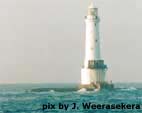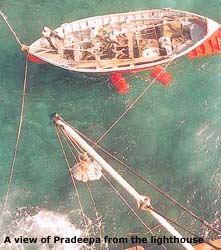
21st May 2000
News/Comment|
Editorial/Opinion| Business| Sports|
Sports Plus| Mirror Magazine

Oddly Occupied
Ocean vigil
 For
us it was all what we had expected – an adventurous excursion to a place
we would probably never see again. But for the four we left behind it would
be a long wait till the next relief operation, with probably another curious
visitor with loads of questions.
For
us it was all what we had expected – an adventurous excursion to a place
we would probably never see again. But for the four we left behind it would
be a long wait till the next relief operation, with probably another curious
visitor with loads of questions.
The Sri Lanka Ports' Authority (SLPA), which operates and manages the coast lights, agreed to accommodate us on its April relief operations to the two offshore lighthouses at the Great Basses and Little Basses. That was only after we signed indemnity forms assuring the SLPA that we would not hold it responsible for damage/loss to life and property.
 We
set off from Kirinda to the Great Basses aboard the SLPA vessel 'Pradeepa
II' guided by Master Joseph Selvanayagam. Pradeepa was loaded with barrels
of fresh water, diesel, vegetables, fish, paint, dry rations, mechanics,
helpers and most importantly the four men who would take over the job of
lighthouse-keepers.
We
set off from Kirinda to the Great Basses aboard the SLPA vessel 'Pradeepa
II' guided by Master Joseph Selvanayagam. Pradeepa was loaded with barrels
of fresh water, diesel, vegetables, fish, paint, dry rations, mechanics,
helpers and most importantly the four men who would take over the job of
lighthouse-keepers.
While most of the first-timers were bent over double being seasick on the morning of April 28, I managed to resist the urge by taking a deep breath of salty air. Then I caught up with S.M.M.Mirzan on his first assignment as Junior Assistant Lighthouse-keeper.
His interest in this odd line of work had been sparked by the conversations of his uncles, all seafaring men. "Forty-five days of work then 45 days of holiday, where else can you find such a job" was an enthusiastic way of looking at things. Newly married he would be stranded on a tower in the middle of the ocean for the next six weeks. "I am taking some books so that I can improve my spoken English," he says. As the junior assistant it would be his job to keep the kitchen fires burning during the stay at the Great Basses.
 Yet,
the 'pros' at this business, J.P Padmasiri, the Principal Lighthouse-keeper
(PLK) and B.K. Rahuman, the Assistant Lighthouse-keeper were less than
enthusiastic about being caged in.
Yet,
the 'pros' at this business, J.P Padmasiri, the Principal Lighthouse-keeper
(PLK) and B.K. Rahuman, the Assistant Lighthouse-keeper were less than
enthusiastic about being caged in.
"Once, I accidentally cut a finger badly. The PLK at that time signalled a fishing boat to come near the reef, swam to it, went ashore and returned with help," Rahuman says, explaining the inaccessibility. He is the champion swimmer among the lighthouse-keepers. A bit of spearfishing is his relief from the loneliness of the long vigil.
"We get up around 6 a.m., switch off the lights, get breakfast ready, radio the Dondra lighthouse at 9 a.m., do the necessary maintenance work, lunch, rest, radio again at 5 p.m. and then switch on the lights again," Padmasiri ran through the daily routine at the lighthouse.
By this time the freshly painted 125-metre Great Basses lighthouse which was just a flash seen every 10 seconds during most of the voyage was in clear sight. Four 'dots' were vigorously getting things ready for the landing.
Unshaven men in rubber boots and fishing hooks, hurricane lanterns and jealously guarded potted plants floated into my mind; the images formed long ago through Secret Seven books.
Suddenly the daydream was over, it was action time. The tug could go no more towards the shallow waters near the reef. The rescue and whaler boats that we had been dragging behind us suddenly moved into the fore. The provisions were loaded onto the whaler. The whaler was then dragged by the powerful rescue boat towards the lighthouse. The whaler anchored a few metres away from the lighthouse and the unloading began, using the crane at the lighthouse. Meanwhile, we whizzed along in the rescue boat and boarded the Great Basses, thanks mostly to the skill of the two who handled the boat.
And we were there. This was the destination of our one-and-a half-hours at sea, the home of our oddly occupied men.
The base of the tower was a huge tank where all the rainwater collected in the gutters would end up. Clambering up this base we were in the gallery/storage area of the lighthouse. It was full of cupboards and barrels with a trapdoor to the water tank below. Climbing up a narrow staircase with the brass parts as shiny as they would have been when it was built in 1872, we reached the noisy generator room. Next was the panel room with all the controls of the generator and backup systems, an aromatic smell signalling that the kitchen was above. On the next floor was the PLK's room. The rest of the crew slept in the room above this. Farther up was the visiting room complete with TV, VCR and the controls of the lights that were in the dome above.
The gallery around the visiting room provides a spectacular sight: deep blue waters all around except for the lighter patch we were on with a splashing white boundary around it. We spotted a group of dolphins enjoying the abundance of fish around the reef. With binoculars in hand this is a favourite gazing spot for the lonely keepers.
On the floor below, settling down on a cosy bunk with an unending carpet of blue and its inherent hiss coming through an open window I struck up a conversation with Assintant Keeper Bandula Prathapasinghe. "We are like birds, well-fed but trapped in a cage. We can't even go out for a kottu rotti if we feel like it. Our freedom is very limited." His main grievance is that their turn at the offshore lighthouses brings them no added payments, even though it's a much harder life than that at a lighthouse on the mainland.
The long stay at the lighthouses cripples their mental capabilities. Boredom and loneliness form a vicious circle, with even those determined to make good use of their time, getting trapped in this feeling of uselessness, he adds.
"We even get socially isolated when we go back home. We have missed weddings and funerals and so on. We find it hard to pick up the threads again. And just when we are settling down we have to come back here." For Prathapasinghe who had marvelled at the lighthouses while working on merchant vessels, the magic had all but vanished.
The meal prepared for us was appetizing. It was fresh water to drink and sea water to wash your hands. The rationing of fresh water is one of the many hardships faced by the keepers. Bathing in the sticky salty water day in, day out provides little comfort.
By now it was time to go back. But this time round the sea was too rough for the rescue boat to come near the reef. So we hung on the crane, three at a time and made a perilous swing towards the whaler. A sudden rush of a wave and the ropes attached to the crane were dragged far across the reef. So there we were hanging on a rope right between the reef and the whaler with a heaving sea below us.
It was some time before the ropes were gathered and we were swivelled towards the whaler. Still swinging madly we had to let go of the rope at the correct time or we would land in the sea or atop barrels and cans! We landed safely, though not very gracefully.
Then it was back to the Pradeepa II and Kirinda. Early the next day we would head for the Little Basses. A 30-kilometre trip, crossing the shallow reefs, in to the deep sea and back. A trip that could sometimes take a gruelling five hours meant that 'outsiders'were rarely encouraged to visit. However, Chief Lighthouse Inspector B. Piyasena assures us that if the Great Basses looked masculine the Little Basses were the more beautiful and feminine.
(To be continued)








![]()
Front Page| News/Comment| Editorial/Opinion| Plus| Business| Sports| Sports Plus| Mirror Magazine
Please send your comments and suggestions on this web site to

